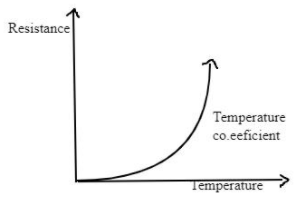
The units of temperature coefficient of resistance are:
(A)$\Omega {K^{ - 1}}$
(B)${K^{ - 1}}$
(C)$\Omega K$
(D)${(\Omega K)^{ - 1}}$
Answer
582.9k+ views
Hint: The change in the resistance per degree increase in temperature is defined as temperature coefficient of resistance. When measuring the temperature of the objects with the rise or fall in the temperature, attention is given to the effects of electronic measuring temperature.
Complete step-by-step answer:
The resistance change factor per degree Celsius is called the temperature coefficient of resistance. It is denoted by α. It is defined by the following equation.
$\dfrac{{dR}}{R} = \alpha dT$
Where T is the temperature.
Hence, the unit of temperature coefficient of resistance is an inverse temperature. Therefore, the unit of α is 1/K or K$^{-1}$.
Hence, option (B) K$^{-1}$ is the correct option.
Additional information:
The reason for the dependence of resistance on temperature is the following.
As the temperature increases, several collisions between charge carriers and ions/atoms increase. However, this may not always be the reason.
The positive temperature coefficient of resistance is defined for those materials whose electrical resistance increases with increases in temperature.
The negative temperature coefficient of resistance is defined for those materials whose electrical resistance decreases with increases in temperature.
Semiconductors have a negative temperature coefficient of resistance because as the temperature of semiconductor material is increased the charge carrier concentration increases. As a result, higher numbers of charge carriers are available for the recombination which will increase the conductivity of the semiconductor. Therefore, as conductivity increases the resistivity of the material is decreased due to the rise in temperature. Hence, we call it a negative temperature coefficient of resistance.
Note:
Resistance and electrical resistivity are affected by the change in temperature.
The temperature coefficient of resistance is inverse temperature.

Complete step-by-step answer:
The resistance change factor per degree Celsius is called the temperature coefficient of resistance. It is denoted by α. It is defined by the following equation.
$\dfrac{{dR}}{R} = \alpha dT$
Where T is the temperature.
Hence, the unit of temperature coefficient of resistance is an inverse temperature. Therefore, the unit of α is 1/K or K$^{-1}$.
Hence, option (B) K$^{-1}$ is the correct option.
Additional information:
The reason for the dependence of resistance on temperature is the following.
As the temperature increases, several collisions between charge carriers and ions/atoms increase. However, this may not always be the reason.
The positive temperature coefficient of resistance is defined for those materials whose electrical resistance increases with increases in temperature.
The negative temperature coefficient of resistance is defined for those materials whose electrical resistance decreases with increases in temperature.
Semiconductors have a negative temperature coefficient of resistance because as the temperature of semiconductor material is increased the charge carrier concentration increases. As a result, higher numbers of charge carriers are available for the recombination which will increase the conductivity of the semiconductor. Therefore, as conductivity increases the resistivity of the material is decreased due to the rise in temperature. Hence, we call it a negative temperature coefficient of resistance.
Note:
Resistance and electrical resistivity are affected by the change in temperature.
The temperature coefficient of resistance is inverse temperature.

Recently Updated Pages
Master Class 9 Social Science: Engaging Questions & Answers for Success

Master Class 9 Science: Engaging Questions & Answers for Success

Master Class 9 English: Engaging Questions & Answers for Success

Master Class 9 Maths: Engaging Questions & Answers for Success

Master Class 11 Economics: Engaging Questions & Answers for Success

Master Class 11 English: Engaging Questions & Answers for Success

Trending doubts
Which places in India experience sunrise first and class 9 social science CBSE

Fill the blanks with the suitable prepositions 1 The class 9 english CBSE

Write the 6 fundamental rights of India and explain in detail

Difference Between Plant Cell and Animal Cell

What is the Full Form of ISI and RAW

Golden Revolution is related to AFood production BOil class 9 social science CBSE




